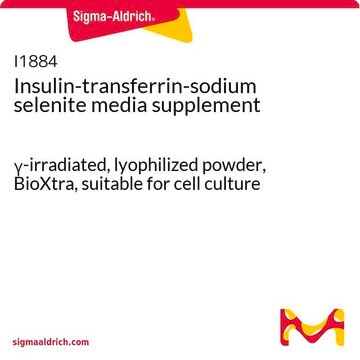11074547001
Roche
Insulin-Transferrin-Sodium Selenite Supplement
suitable for cell culture, lyophilized, pkg of 50 mg (for 5 l medium)
Sinónimos:
ITS
About This Item
Productos recomendados
biological source
human serum (transferrin)
synthetic (sodium selenite)
Quality Level
recombinant
expressed in human cells
sterility
non-sterile; 0.2 μm filtered
assay
>98% (Transferrin, SDS-PAGE)
>99% (Insulin, HPLC)
>99% (Sodium selenite)
form
lyophilized
packaging
pkg of 50 mg (for 5 l medium)
manufacturer/tradename
Roche
technique(s)
cell culture | mammalian: suitable
solubility
water: miscible
storage temp.
2-8°C
Gene Information
bovine ... INS(280829)
human ... TFRC(7037)
Categorías relacionadas
General description
Source: Insulin- bovine pancreas; transferrin- human serum; Sodium selenite-synthetic
application
Preparation Note
Storage conditions (working solution): -15 to -25 °C.
Prepare appropriate aliquots and avoid repeated freezing and thawing.
Reconstitution
Further dilution with culture medium.
Other Notes
Storage Class
11 - Combustible Solids
wgk_germany
WGK 1
flash_point_f
does not flash
flash_point_c
does not flash
Certificados de análisis (COA)
Busque Certificados de análisis (COA) introduciendo el número de lote del producto. Los números de lote se encuentran en la etiqueta del producto después de las palabras «Lot» o «Batch»
¿Ya tiene este producto?
Encuentre la documentación para los productos que ha comprado recientemente en la Biblioteca de documentos.
Los clientes también vieron
Nuestro equipo de científicos tiene experiencia en todas las áreas de investigación: Ciencias de la vida, Ciencia de los materiales, Síntesis química, Cromatografía, Analítica y muchas otras.
Póngase en contacto con el Servicio técnico








